

BEIJING, March 2 -- Among the more than 10,000 artifacts unearthed so far from the 2,000-year-old tomb of Haihunhou, the Marquis of Haihun, are treasures of great historical values, said archeologists.
The tomb, which dates back to the Western Han Dynasty (206 BC - 24 AD), is the best-preserved tomb of that period ever found in China. It is the final resting place of Liu He, grandson of Emperor Wu, whose reign ushered in one of the most prosperous periods in China's history.
The following is a breakdown of the top discoverers. Some will be on display at Beijing's Capital Museum from Wednesday, the first time they will have been seen by the public.
MARQUIS SEAL
The tomb master is the Marquis, Liu He.
At the show in Beijing, relics from the interior coffin of the tomb are expected to be put on display for the first time. The most attractive one is likely to be the marquis' private seal, which was key to uncovering the identity of the tomb master.
Liu was given the title "Haihunhou" after he was deposed as emperor after only 27 days, dethroned by the royal clan over, what they said was, a lack of talent and morals. Haihun is the ancient name of a very small kingdom in north Jiangxi.
PORTRAIT OF CONFUCIUS
Archeologists pieced together a broken lacquer screen found in the main chamber of the tomb, which is a portrait of Confucius.
Text reading Confucius, the name of his pupil Yan Hui and the name of his father Sulianghe can all be deciphered on the screen.
The finding of the Confucius portrait in the marquis's tomb indicates Confucius' teachings were prevalent among the ruling class in the Western Han Dynasty.
The screen, however, is not among the items to be displayed, as it is too delicate.
CHARIOT BURIAL
Haihunhou Cemetery is in Nanchang, capital of Jiangxi Province. It covers some 40,000 square meters with eight tombs and a chariot burial site, with walls that stretch for almost 900 meters.
Archeologists discovered five well-preserved horse-drawn vehicles, each with four sacrificed horses, in the corridor of the main tomb of Haihunhou.
Vehicles with four horses indicates that the owner of the vehicle was among the highest echelons of the Han Dynasty.
More than 3,000 accessories embellished with gold and silver were also found.
Although the vehicles will not be included in the show, some of gold and silver accessories will be on display.
CHINA'S OLDEST DISTILLER?
A vessel believed to be a distiller with remains of taro, the raw material for Japanese saki, was also found.
Archeologists are still working to confirm whether the vessel was used for making liquor. If it is proven, it would push back China's history of making distilled spirit 1,000 years earlier. Currently there is evidence of the practice starting during the Yuan Dynasty (1271-1368).
CHIMES, FIGURINES
Two sets of chimes were also unearthed. One is a 10-piece set, and the other is a 14-piece set. The latter will be at the Beijing show.
The chimes were restored by renowned bronze relic expert Yang Xiaolin. He said the pieces, each bell shaped, have been cleaned and polished. The pieces made of gold-gilded bronze with decoration marks can still make beautiful sounds.
Besides the chimes, there is a set of iron chime and other musical instruments including Guqin (or Chinese zither) and panpipe, as well as 36 figurines of musicians.
The outfit of musical instruments suggests the characters were dignitaries in ancient China.
SMOKE-ABSORBING LAMPS
Two bronze lamps that can "swallow" smoke were unearthed from the Haihunhou tomb.
The lamps are both in the shape of a goose catching a fish in its mouth. The light is attached to the fish. Smoke emitted during the burning of wax enters the bird's body via an intake on the fish, travel through its neck and is then dissolved by water in the hollow belly.
It is both an artwork and an example of ancient innovation. The lamps can be dismantled for cleaning and have swinging lamp shades to adjust the brightness.
TROVE OF GOLD ITEMS
The amount of gold items unearthed from the Haihunhou tomb is the largest single batch ever found in a Han Dynasty tomb, according to archeologists.
A total of 378 gold artifacts including 189 very large gold coins were found.
The round coins weigh about 250 grams each, while gold hoof-shaped coins weigh from 40 to 250 grams.
At the bottom of the gold hoof, there are different characters of "up", "middle" and "bottom."
WUZHU BRONZE COINS
More than 10 tonnes of Wuzhu bronze coins were unearthed from the tomb. The coins were arranged in groups of 1,000, with each set strung on a cord.
Before the finding, historical documents had suggested that a string of 1,000 coins was a monetary unit, which was thought to have originated in the Tang Dynasty (618-907). This is the first hard evidence of the monetary unit, and has pushed the original date back 600 years.
Archeologists had to crouch on a wooden board balanced precariously over a tomb bed 9 meters below to meticulously count and clear the coins. The coins are strung on hemp ropes. Although the ropes had weathered, people were able to identify the strings.
Six complete strings of bronze coins were cleared out at the dig. One of them will be brought to the show.
The excavation of Haihunhou Tomb began in 2011. It has been recognized as a model archeological research and relic protection project. In addition to the relics, archeologists are preserving the tomb site and preparing to apply for it to be inscribed on UNESCO's world heritage list.
Jiangxi's cultural department cataloged each find. Several labs and research teams have been working separately on archaeobotany, zooarchaeology as well as studies on textiles, metals and historical records.
 China has world's largest high-speed rail network
China has world's largest high-speed rail network Top beauties in Chinese provinces
Top beauties in Chinese provinces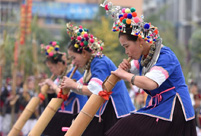 600 people attend Lusheng playing contest in S China
600 people attend Lusheng playing contest in S China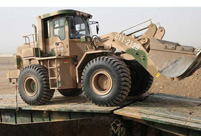 Engineer troop builds bridge in real combat conditions
Engineer troop builds bridge in real combat conditions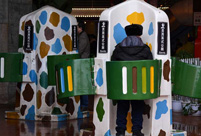 You can urinate in public in Chongqing
You can urinate in public in Chongqing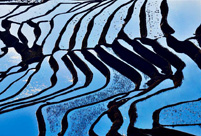 Rice terrace scenery in southwest China's Yunnan
Rice terrace scenery in southwest China's Yunnan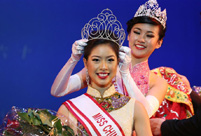 2016 Miss Chinatown USA pageant held in San Francisco
2016 Miss Chinatown USA pageant held in San Francisco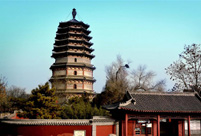 Ancient pagodas across China
Ancient pagodas across China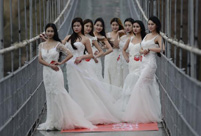 Wedding dress show up in the air
Wedding dress show up in the air Top 20 hottest women in the world in 2014
Top 20 hottest women in the world in 2014 Top 10 hardest languages to learn
Top 10 hardest languages to learn 10 Chinese female stars with most beautiful faces
10 Chinese female stars with most beautiful faces China’s Top 10 Unique Bridges, Highways and Roads
China’s Top 10 Unique Bridges, Highways and Roads Supply side focus of two sessions
Supply side focus of two sessions Joint letter disrespects China’s rule of law
Joint letter disrespects China’s rule of law How the ‘otaku’ lifestyle is helping young people reclaim their health
How the ‘otaku’ lifestyle is helping young people reclaim their health Foreign nationals more confident in pressing IPR charges in China thanks to legal changes
Foreign nationals more confident in pressing IPR charges in China thanks to legal changesDay|Week